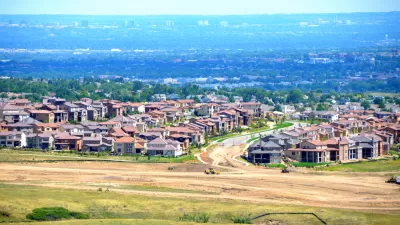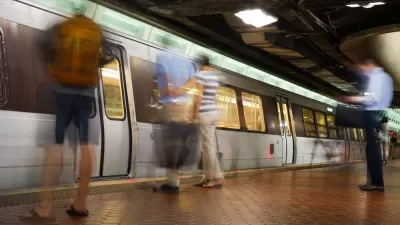The country cannot hope to achieve its goals for the reduction of greenhouse gas emissions without fundamentally rethinking its land use and development patterns, according to this article.

The Biden administration in April announced a bold target to reduce the country's greenhouse gas emissions by 50 percent from 2005 levels by the end of this decade. A recent report by researchers at the Brookings Institution argues that those targets won't be possible without systems-level changes in very sector of the economy, and unfortunately, the strategy announced by the Bien administration only skimmed over a "central driver of the climate crisis": unsustainable land use practices.
Adie Tomer, Joseph W. Kane, Jenny Schuetz, and Caroline George write to recenter land use in climate discussions, stating that the country won't achieve its goals to reduce greenhouse gas emissions by continuing to grow as it has in the past.
"After decades of sprawl, the U.S. has the dubious honor of being a world leader in both building-related energy consumption and vehicle miles traveled per capita. Making matters worse, lower-density development also pollutes our water and requires higher relative emissions during the initial construction," reads the article.
As a prescription for the consequences of the history of land use in the United States, the article proposes: "We must prioritize development in the kinds of neighborhoods that permanently reduce total driving and consume less energy."
"Such human-centered neighborhoods have the added benefit of helping us adapt to climate impacts, improve public health, and promote access to activities. Encouraging their development should be a central part of any national climate resilience strategy," continues the article.
Environmentalists have long connected sprawling development patterns to negative environmental outcomes like air pollution, but the connections between sprawl and the emissions that cause climate change tend to be underappreciated, or deliberately ignored, by even some of the most ardent environmentalists. The international community, led by the United Nations, has recently amplified the blame for climate change on the appetite in the United States for large, gas guzzling automobiles and sprawling development patterns.
FULL STORY: We can’t beat the climate crisis without rethinking land use

Montreal Mall to Become 6,000 Housing Units
Place Versailles will be transformed into a mixed-use complex over the next 25 years.

Planetizen Federal Action Tracker
A weekly monitor of how Trump’s orders and actions are impacting planners and planning in America.

DARTSpace Platform Streamlines Dallas TOD Application Process
The Dallas transit agency hopes a shorter permitting timeline will boost transit-oriented development around rail stations.

Without International Immigrants, the Rural US Population Would Be Falling 58%
Census data shows that population growth in rural areas is due in large part to international migrants.

Dead End: Nine Highways Ready for Retirement
The Freeways Without Futures report describes the nation’s most promising highway removal proposals.

Congressman Proposes Bill to Rename DC Metro “Trump Train”
The Make Autorail Great Again Act would withhold federal funding to the system until the Washington Metropolitan Area Transit Authority (WMATA), rebrands as the Washington Metropolitan Authority for Greater Access (WMAGA).
Urban Design for Planners 1: Software Tools
This six-course series explores essential urban design concepts using open source software and equips planners with the tools they need to participate fully in the urban design process.
Planning for Universal Design
Learn the tools for implementing Universal Design in planning regulations.
City of Mt Shasta
City of Camden Redevelopment Agency
City of Astoria
Transportation Research & Education Center (TREC) at Portland State University
City of Camden Redevelopment Agency
Municipality of Princeton (NJ)
Regional Transportation Commission of Southern Nevada





























